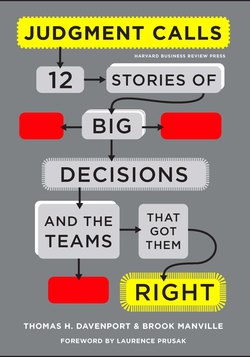Читать книгу Judgment Calls - Thomas H. Davenport - Страница 29
На сайте Литреса книга снята с продажи.
Reflections on WGB Homes's Organizational Judgment
ОглавлениеAs WGB Homes's story illustrates, even small, family-run businesses can benefit from activities to improve organizational judgment. In fact, when one bad decision can sink a company, good decisions are particularly critical.
The hallmark of decision making at WGB Homes is involvement by multiple knowledgeable parties. Greg Burrill, the CEO, has confidence in his own judgment, but he knows that better judgment derives from broader participation. It often makes sense to consult other expert sources in making a decision, and to build in processes and contexts for soliciting and discussing decision alternatives. Greg Burrill still makes the final decision, but he looks for insights and expertise in every place he can find it. A senior executive in an organization can and should listen to many opinions and sources of wisdom, but he or she still needs to make the call in the end.
The WGB story also illustrates a key aspect of decision process design: to delay decision making until more information is available, or to lower the cost of changing your mind if you decide your initial decision was suboptimal. This is, in effect, a way to minimize the cost of poor organizational judgment. It happened only rarely at WGB Homes, but the uncompleted home made it relatively easy to address.
WGB captures its design decisions in its CAD system. When a new or modified design is created, it's captured in digital form so that it can be used again—or serve as the basis for yet another modification. It's a form of knowledge management for house designs—and since WGB is a small firm, virtually any organization with design processes ought to be able to do something similar.
So Burrill's consultation with his informal advisory panel is a great example of building organizational judgment, and his late-configuration approach is a great way to lower the cost of decision making. The company's CAD system is a way to capture good design decisions so they can be reused with little effort. Think of all of the decisions in your company that might be improved if everyone with a good idea were consulted, if plans stayed flexible until the last minute, and if the firm's knowledge had been captured and stored for later reuse. It's a management approach that works for companies and organizations of any size.
